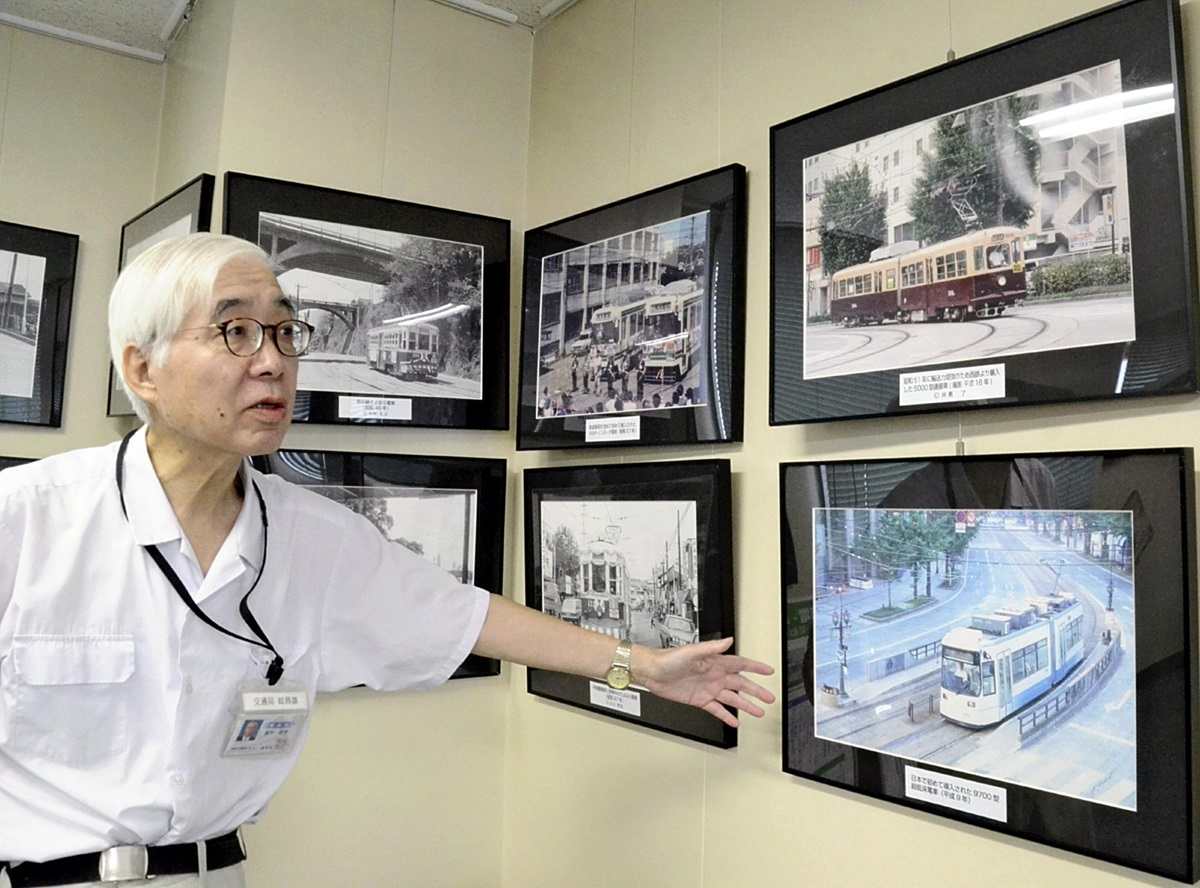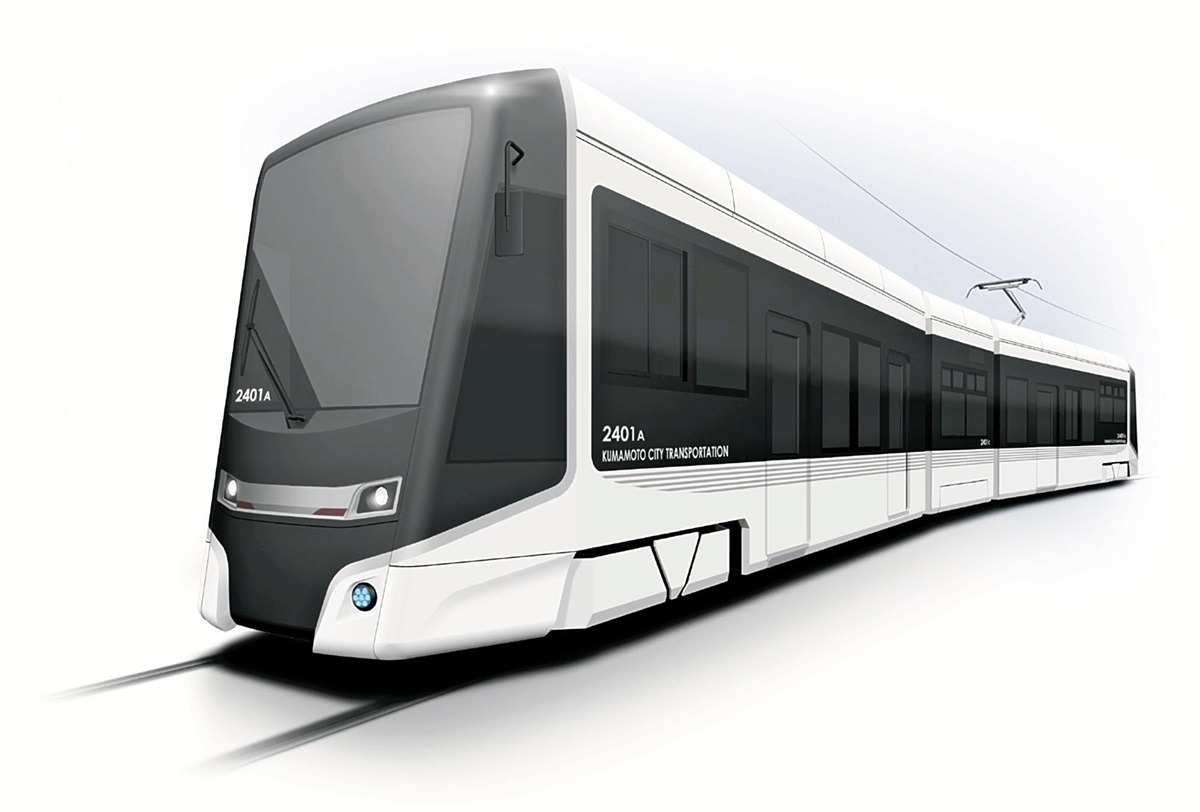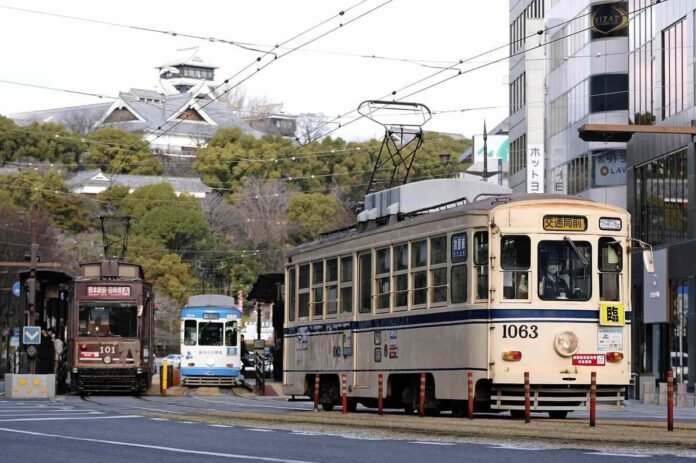Kumamoto’s trams run through the city, with Kumamoto Castle in the background.
11:00 JST, August 24, 2024
KUMAMOTO — The Kumamoto City Tram celebrated its 100th anniversary this month, having survived the threat of demolition and damage caused by the 2016 Kumamoto earthquake.
Although some lines have been scrapped, the tram still winds through the former castle town. With Kumamoto Castle in the background, it still attracts many railway enthusiasts and tourists.
The tram began operating on August 1, 1924, when the city acquired the rights to operate the tram from a private company. The tram originally had two lines, but was expanded over time. In 1959, the total length of the lines was 25 kilometers. The tram reached its peak number of passengers in 1964, when an average of 116,097 passengers rode per day.
“Few people had cars at that time, so it was a valuable means of transportation for residents,” said Toshiyuki Hosoi, 64, an employee of the Kumamoto City Transportation Bureau who was involved in a publication for the tram’s centennial.
“I am sure the love of the local people has kept it going for a whole century,” he said.

Toshiyuki Hosoi talks about the history of the Kumamoto City Tram.
There are 2 lines left
When the tram first opened, there were so many passengers in the cars that the street in front of the Kumamoto Station stop was filled with people unable to get on.
By the 1960s, however, passenger numbers began to decline due to the proliferation of automobiles, pushing the agency into the red. By the 1970s, there was talk of shutting down the entire system.
However, there was a strong demand to maintain “the feet of the people”, as the system was called. In 1979 it was decided to run the tram.
Although some lines have been discontinued, the tram currently operates on two lines, one between Tasakibashi and Kengunmachi stops and the other between Kamikumamoto and Kengunmachi stops, with a total length of about 12 kilometers. In recent years, the tram has had about 10 million passengers per year.

However, due to the COVID-19 pandemic, passenger numbers fell to 6.73 million in fiscal year 2020, or about 60% of the previous fiscal year’s number, and have not yet fully recovered to pre-pandemic levels.
Due to the continuing financial pressure, the tram will be operated under a new system from the next budget year. A foundation will be established to be responsible for the operation, but the city will retain ownership of the tram cars and facilities.
The new system is expected to lead to higher incomes, stable employment and better working conditions.
Happy passengers
In late July, General Matsushita, a 26-year-old tram driver, received about an hour of training under the guidance of an experienced driver. He transported passengers back and forth between the Kengunmachi and Kotsukyoku-mae stops.
“I feel a heavy responsibility to support the daily lives of the passengers,” Matsushita said with a serious expression on his face.
Matsushita is originally from Kagoshima Prefecture and has been fond of trains and buses since he was a child. Although he originally worked for the Kagoshima Prefecture Government Office, he couldn’t give up his dream of becoming a tram driver and joined the Kumamoto City Transportation Bureau in April last year.

Gen. Matsushita trains to drive a streetcar in Kumamoto.
Due to their limited hiring budget, the Kumamoto City Tram has been consistently short of drivers. In April last year, there were only 86 drivers, but that number has since dropped by about 10% due to layoffs and long-term sick leave. In June last year, the tram’s schedule was revised, cutting services by 10%.
Applicants for a tram driver must pass a licensing exam, which is only held twice a year, and then undergo training. It takes at least eight months before a new employee is allowed to drive a tram independently.
Matsushita, who had failed the exam in the past, retook it while working as a conductor and passed in June this year. He will become a permanent driver in October.
He says he was rewarded by the smiles and words of thanks from passengers getting off the tram.
“When I ride the tram regularly, I want to make sure that passengers are happy that they took the tram,” Matsushita said.
New three-car tram
The tram will use a new three-car train this year. The new train should eliminate the morning and evening congestion that plagues the current system of one- and two-car trains.

A conceptual sketch of the exterior of a new tram car
Currently, 24 of the 54 tram cars, or about 40% of the total, are 50 years or older. Incidents such as doors opening while the tram is moving are common, probably due to the age of the car. The Shinsuizenji Station stop, which connects to the JR Hohi Line, also has a capacity problem, leaving some passengers unable to board the overcrowded cars during morning rush hours.
The new three-car tram has a black-and-white exterior, designed to match the colors of Kumamoto Castle. It is about 21 meters long and can carry 112 passengers, 26 more than a two-car tram. It will also have special space for wheelchairs and strollers. A total of 12 new trams are planned to enter service by fiscal year 2030.



